Tracking Rhinos in Zimbabwe
Tracking Rhinos in Zimbabwe
By Deborah “Koala” Vandruff
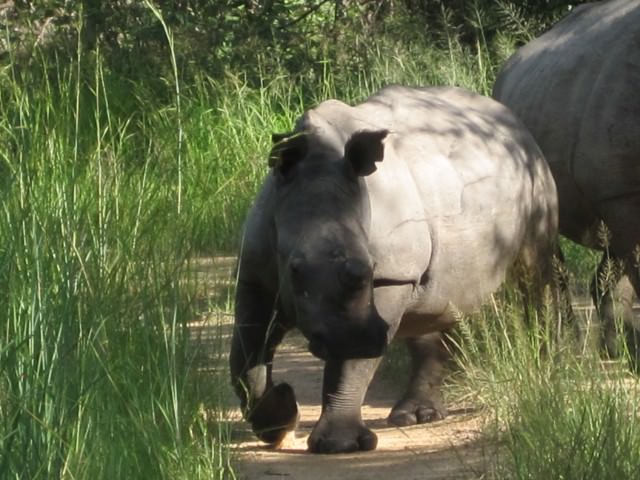
Tracking Rhinos in Zimbabwe
The rhinos had been allusive on the trip thus far; in the Serengeti, we saw some small dark shapes far in the distance. When they moved, we could barely make out the shape of a large horn on the head of a bulky animal. We took the sighting anyway and felt happy to “see” one of the “Big Five” (rhino, Lion, elephant, buffalo, and leopard) – so called because they are the most dangerous African animals to hunt.
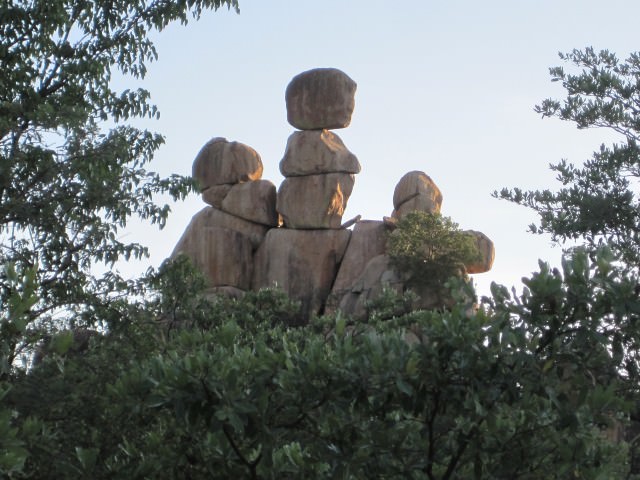
Matopos National Park in Zimbabwe
Not seeing a rhino close up was not a big source of angst actually since we saw so many wonderful animals up close and in large numbers. What are the chances of seeing a rhino, anyway unless you go to a preserve or the zoo?
On our visit to Hwange National park in Zimbabwe, we saw even more lovely animals, countless zebra, wildebeest, giraffe, even a group of kudu – the males with graceful curled horns and both sexes sporting their attractive white stripes down their sides.
We went on 4 game drives seeing something new everyday including a large family of lions lazing in the shade. And on the last day there, our guide stopped the truck suddenly and pointed to an animal that looked to us like yet another wildebeest. It was, however a white rhino. Before we all had a turn at binoculars the animal went behind a bush and that was it. On most game drives, you only get to see what you can see from the vehicle and luckily for the animals, the guides can’t just make their own trails, so vehicles stay on the network of maintained roads. There is no getting out of the truck for the visitors except at designated areas. Guides need certification to take people out tracking and most don’t have it.
We had not expected rhinos when we signed on to spend a day at Matopos National Park in southern Zimbabwe. The big attraction we expected to see were the huge balancing rocks that Zimbabwe is known for and the cave paintings done by the bushmen thousands of years ago. But when the guide came to tell us about the trip we were on for the next day, tracking rhinos on foot was most of the day’s activity.
Our guide for this trip grew up playing as a kid in this area. You could tell he could be doing no other job as he was so enthused about showing us this park. So, off we went in the morning to find the rhinos. We were able to see the plants and rocks and terrain that the animals live in. The amazing rock paintings are still so vivid and clearly show depictions of people and animals of long ago. The balancing rocks that are a result of ancient volcano activity are everywhere to be seen and in particular abundance in this area.
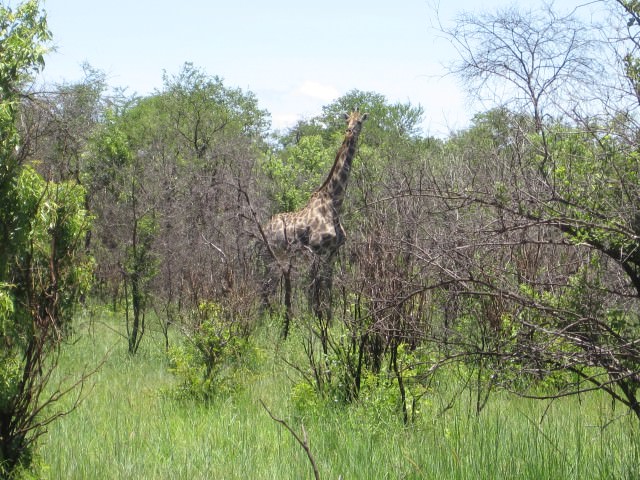
Giraffes in Matopos National Park in Zimbabwe
After several trips out into the bush looking for rhino sign and seeing “only” giraffe and zebra, we ate lunch by a small lake with an active group of hippos. It was such a treat to get out of the truck and be on the same level as the animals. We traveled through the bush single file and silent…
After much walking and being gawked at by giraffes, it was in the truck that we came across the big mama and baby rhino pair. We got out and tracked behind them as they foraged for food – they were pretty calm because they are the more mellow “white rhinos”. We were told that we could never get this close to a black rhino. (white rhinos are actually grey in color. The name “white” comes from a translation error when scientists noted that this type of rhino had a “wide” mouth – oops!)
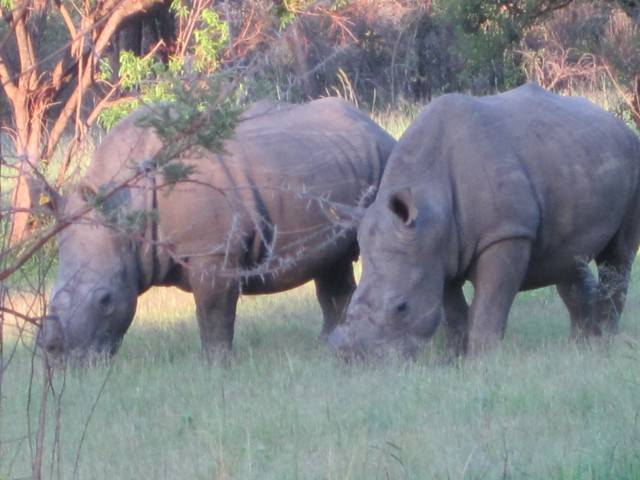
Rhino in Matopos National Park in Zimbabwe
We were all pretty happy with the day after seeing the Mom and calf up so close and were on our way out of the park and there were these two brothers grazing right by a place where we had been out tracking them earlier.
You would not think you could miss something as big as a rhino, but they can hide. Anyway, we were lucky to catch them in the last glow of the day. We were past time to be out as they are supposed to close the park at 6pm, but our guide (who thought that was a lousy rule) stopped so we could get out and have a good look. Since we were only one of 2 groups in the park that day, they were unlikely to lock us in.
So much for rules… actually we were allowed to be out of the truck since our guide was so highly qualified according to Zimbabwe’s game guiding rules. He also carried a rifle-just in case – as for the poachers, they are an unfortunate reality. So much so that, the poor rhinos in the park had been dehorned to make them less vulnerable to poachers who have in the past done great damage to the herd. They are still greatly at risk as apparently some Asian men think the ground horn works better than Viagra. Ugh!
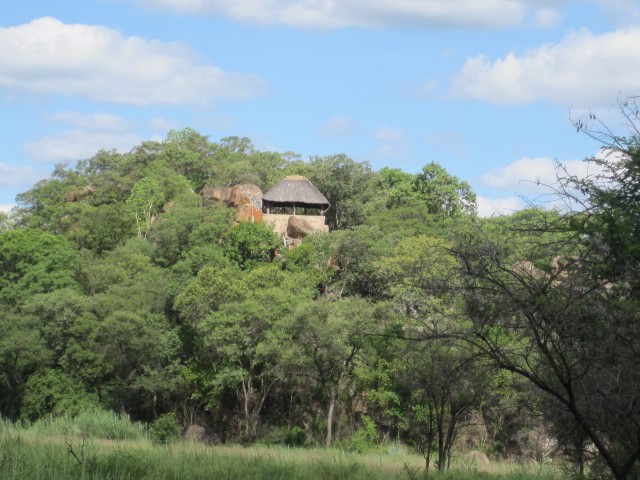
The poacher lookout hut in Matopos park – poachers are said to be shot on sight.
So, we had a lovely day tramping about in the bush, being amazed by the balancing rocks, the vastness of the park, so quiet and yet full of life. We were reminded of how tiny a blip in history we are by gazing at the ancient rock paintings. One of the paintings is of a rhino – at least they have not changed much over the ages. And we saw our rhinos at last and up close. A sight I never expected to see but feeling richer for the experience.
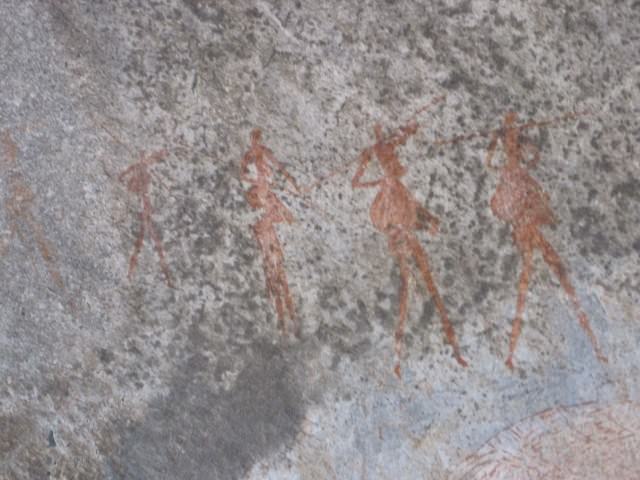
Zimbabwe – Matopos Park
Another remarkable day in Zimbabwe!
For More Information:
– Matobo Hills is a UNESCO site.
BIO:
Deborah “Koala” Vandruff makes her home in Anchorage, Alaska. She has recently retired from her work as a nurse at the Alaska Native Medical Center and hopes this will give even more time for exploring the parts of the world she has on “the list” of must see places. Besides travel, she is an avid gardener which makes her love to travel to see and work on gardens. She has worked on WWOOF (worldwide workers on organic farms) farms in Mexico and Italy and plans to do many more. She has been published previously in a travel book “Riding the Hulahula to the Arctic Ocean – A Guide to 50 Extraordinary Adventures for the Seasoned Traveler” (published by National Geographic Society) and tries to keep a blog at www.sandkvistas.wordpress.com. She recently spent 3 months traveling through 6 countries in East Africa and is looking forward to fishing season in Alaska.

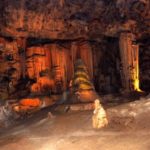







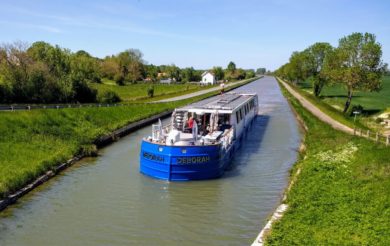


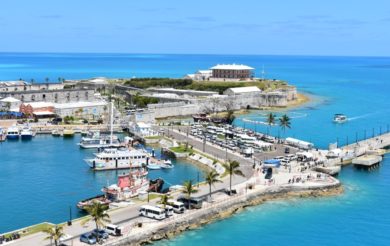



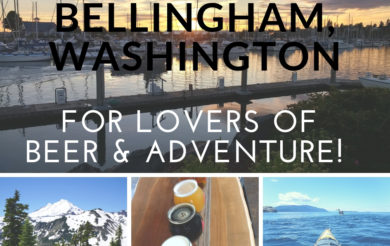
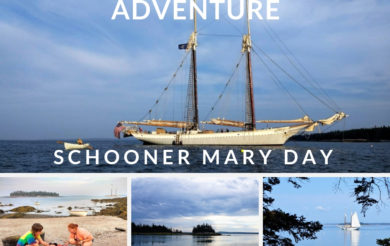
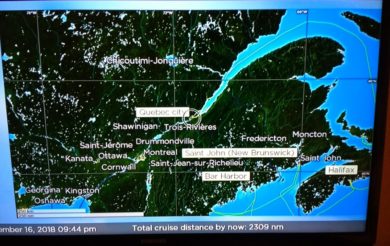


2 Responses to Tracking Rhinos in Zimbabwe